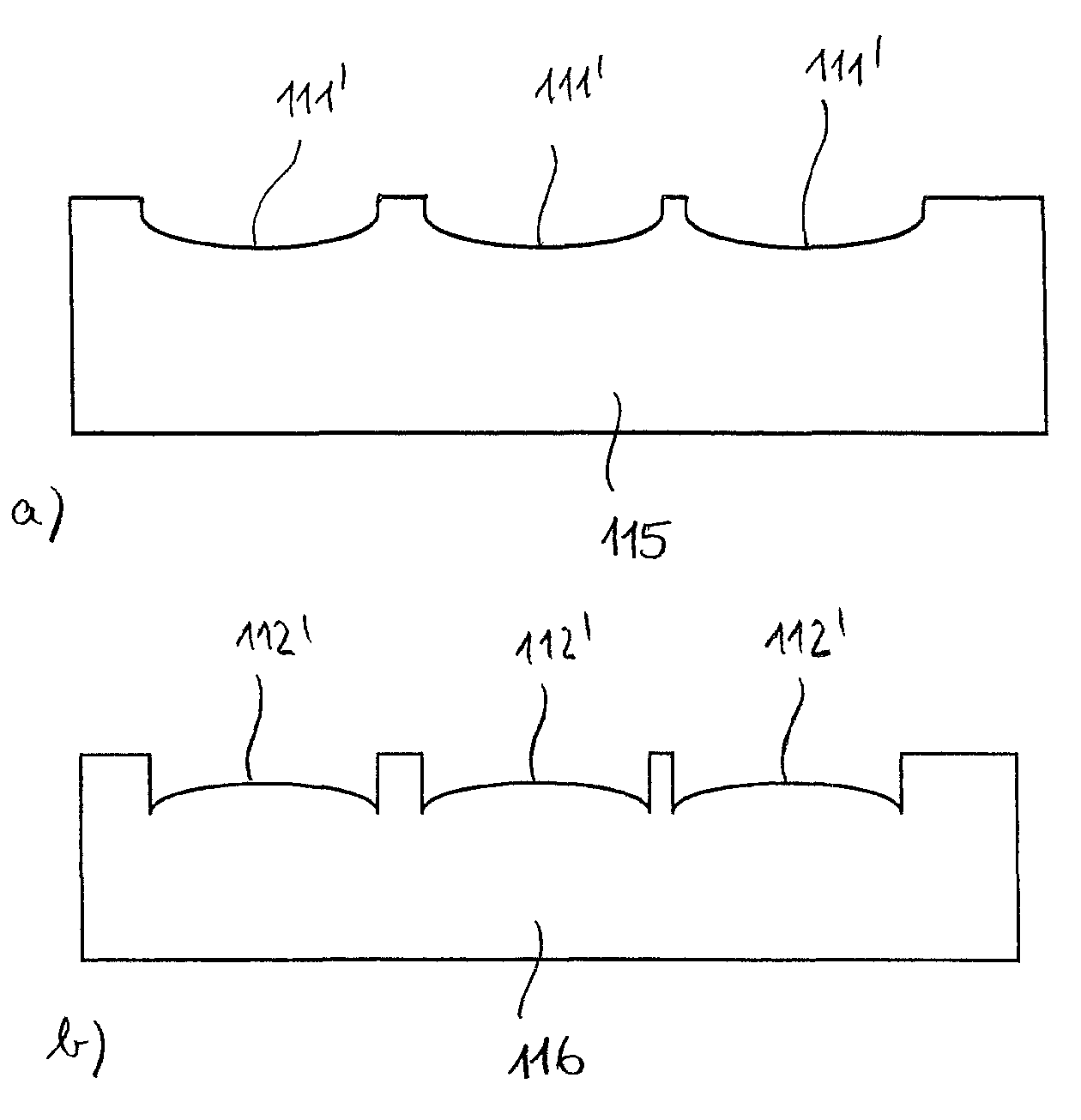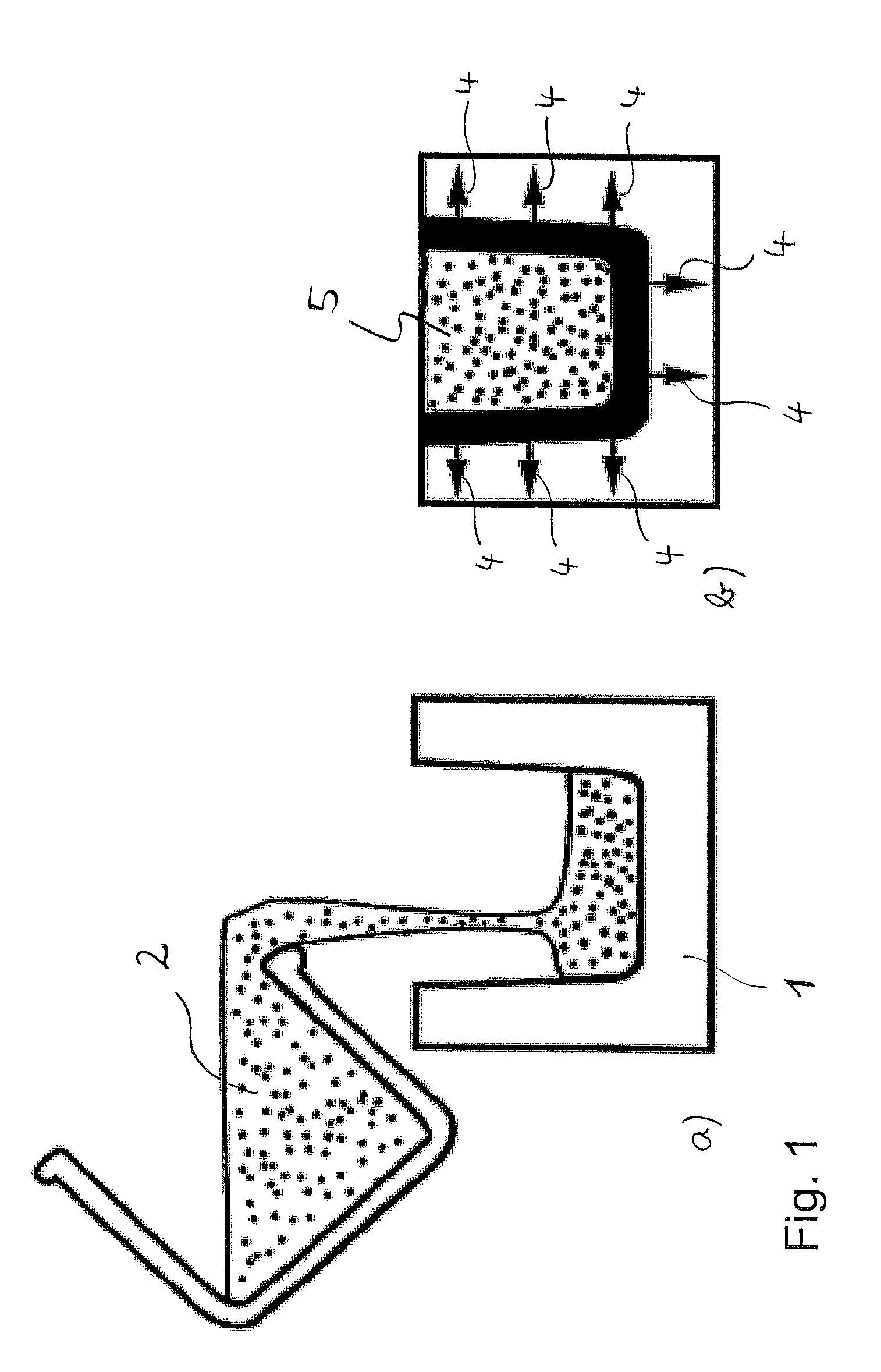Moulding tool for moulding a ceramic green body and use of said moulding tool
- Summary
- Abstract
- Description
- Claims
- Application Information
AI Technical Summary
Benefits of technology
Problems solved by technology
Method used
Image
Examples
Example
EXEMPLARY EMBODIMENT 1 FOR A LENS 110
See FIG. 3
[0105]FIG. 3 shows a lens 110 produced by use of the moulding tool according to the present invention for the application of digital projection with the following parameters:
[0106]left surface 111right surface 112diameter D15 mmthickness d 4 mmcurveconvexconcaveradius of the curve17.77 mm36.24 mmK−0.458 (asphere)0 (sphere)a12.92E−30a23.87E−30a34.40E−80a400applicationdigital projection
[0107]A moulding tool according to the present invention 115 for slip casting is shown in FIG. 4a, displaying the convex left surface 111 with the contour 111′. A moulding tool according to the present invention 116 for slip casting is shown in FIG. 4b, displaying the concave right surface 112 with the contour 112′. In any of the shown moulding tools 115 and 116 there are contours 111′ and 112′ for three lenses, being laterally located next to each other. The moulding tool does not have to be limited to the contours of three lenses but could also comprise o...
Example
EMBODIMENT 2 FOR A LENS 210
See FIG. 7
[0113]FIG. 7 shows a lens 210 obtained by using a moulding tool according to the present invention for application in the field of digital photography (DSC camera) with the following parameters:
[0114]left surface 211right surface 212diameterD1 = 9.89 mmD2 = 8.47 mmthickness d 2.86 mmcurveconvexconvexradius of the curve26.332 mmK0 (sphere)0 (sphere)applicationDSC camera
[0115]FIG. 8 shows moulding tool pairs 215, 216 resting above each other for slip casting, wherein the entire tool composed from moulding tool parts 215, 216 displays both surfaces 211, 212 of lens 210. The pairs of contours 211′ and 212′ each show the shape of a lens. In order to obtain a body that is as massive and as homogeneous as possible, the volume shrinkage by sherd formation can be balanced by re-filling slip into the mould. The re-filling of slip takes place through a channel 218 that is present within the moulding tool 215 leading to each of the lens contours.
Example
EMBODIMENT 3 FOR A LENS 310
See FIG. 9
[0116]FIG. 9 shows a lens 310 obtained by using a moulding tool according to the present invention for application in the field of digital photography (SLR camera) with the following parameters:
[0117]left surface 311right surface 312diameterD1 = 8.55 mmD2 = 11.82 mmthickness d3.4 mmcurveconcaveconvexradius of the curve13.68 mm12.46 mmk5.22 (asphere)0 (sphere)a100a2−9.523E−50a300a45.653E−90applicationdigital photography (SLR)
PUM
| Property | Measurement | Unit |
|---|---|---|
| Length | aaaaa | aaaaa |
| Surface roughness | aaaaa | aaaaa |
| Surface roughness | aaaaa | aaaaa |
Abstract
Description
Claims
Application Information
 Login to View More
Login to View More - R&D
- Intellectual Property
- Life Sciences
- Materials
- Tech Scout
- Unparalleled Data Quality
- Higher Quality Content
- 60% Fewer Hallucinations
Browse by: Latest US Patents, China's latest patents, Technical Efficacy Thesaurus, Application Domain, Technology Topic, Popular Technical Reports.
© 2025 PatSnap. All rights reserved.Legal|Privacy policy|Modern Slavery Act Transparency Statement|Sitemap|About US| Contact US: help@patsnap.com



